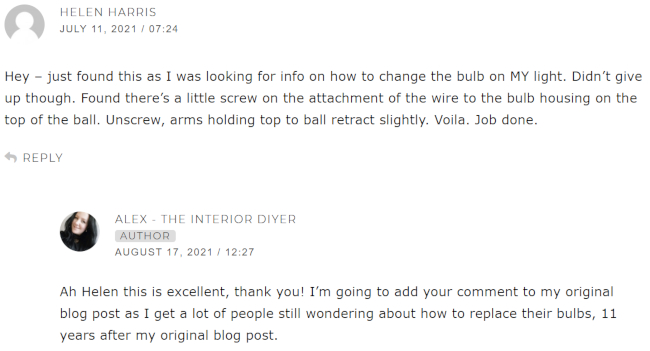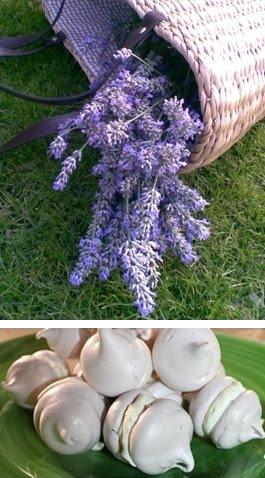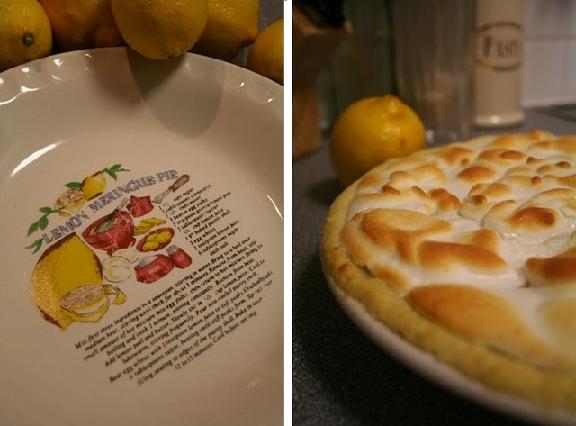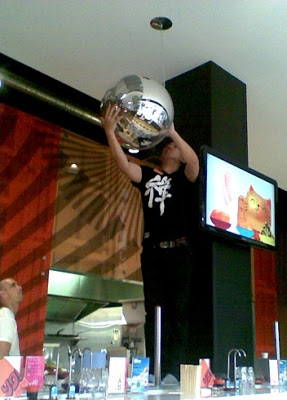How many people does it take to change Tom Dixon’s light bulb?
This afternoon my boyfriend and I stopped off for some yummy dinner at Yo! Sushi on Clarendon Street in Dublin. While we were tucking into our tasty plates, I was taking note of a minor design crisis to the left.
What had happened was one of the light bulbs had gone in one of the Tom Dixon Mirror Ball lights. No biggie, it happens. But what I found interesting {to the embarrassment of my boyfriend} was that it took 3 staff members to try to change the bulb. After 20 minutes and countless attempts of trying to get into the light fixture, they all gave up.
I’ve commented on the lights in Yo! Sushi many times, as I am a fan of Tom Dixon. I’m really hoping, for Tom’s sake, that there’s a certain knack to changing the bulbs. I will now save you all from a rambling rant about the lack of a manual which, if the bulbs are that difficult to change, should have been on the premises.
After witnessing the ordeal the staff went through to try to change one light bulb, I can’t help but wonder how practical these specific light fixtures are. Again, I’m hoping for Tom’s sake that there’s a lot less involved in changing the bulbs, and that there’s a trick to it. I’ve never worked with or encountered one of Tom Dixon’s lights up close, but going forward I’ll need to figure one out before I suggest using them in the future, after what I’ve seen today. They’ve since managed to change the bulb. Or maybe it was easier just to replace the light?
Dear Tom, I have not yet lost faith.
2021 EDIT: I’ve received so many comments and emails recently about how near-impossible it is to change these lightbulbs so I think I’ve lost most of my faith in these fixtures at this point.
2021 UPDATE: It only took 11 years, but we have a solution! Special thanks to Helen for solving this design mystery:

2022 UPDATE: Another helpful answer from Tom below! Maybe … Tom Himself?

Lavender delights
 My weekend treat is to wake up earlyish on Saturday morning, and watch cookery shows on BBC 1. This usually results in me making said cookery items, since I tend to watch these shows on an empty stomach. Without fail, each week I’m in the kitchen trying the latest recipes. Scrumptious fish pie by Hugh Fearnley-Whittingstall, Jamie Olivers homemade pasta, onion rings by Rick Stein, and this week, lavender cream meringues by Valentine Warner.
My weekend treat is to wake up earlyish on Saturday morning, and watch cookery shows on BBC 1. This usually results in me making said cookery items, since I tend to watch these shows on an empty stomach. Without fail, each week I’m in the kitchen trying the latest recipes. Scrumptious fish pie by Hugh Fearnley-Whittingstall, Jamie Olivers homemade pasta, onion rings by Rick Stein, and this week, lavender cream meringues by Valentine Warner.Ingredients
- Newer Posts
- 1
- …
- 197
- 198
- 199
- 200
- 201
- Older Posts


